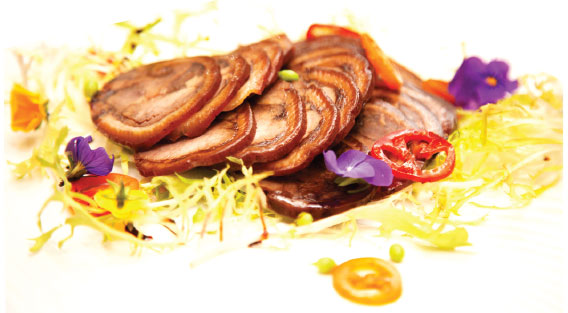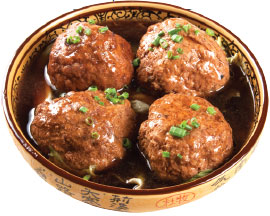Priming for winter in autumn

Editor's Note: China is divided into as many culinary regions as there are different ethnic groups. Its geographical diversity and kaleidoscopic cultural profiles contribute to the unending banquet of flavors.
The oppressive temperatures of summer had us generally wilting, shedding weight as we battled heat-challenged appetites and dehydration. So it is a relief now that autumn is officially here and the weather is cooling significantly.
Along with the cooling, the melons are growing, and soon the pumpkins, plump and juicy, will decorate our tables with their fall colors.
| Autumn is considered a season to prime the body for the coming demands of winter. Mutton hotpot (above), braised meat (bottom) and meatballs are among the popular dishes. Photos Provided to China Daily |

This is also the time when northern Chinese start cooking heartwarming stews and braised meats full of nutrition in an annual culinary ritual called tieqiubiao, roughly translated into "autumn preparations" or "priming in autumn".
This officially starts from the first solar term of autumn, liqiu, the "beginning of autumn", which coincides with the first week of August. However, the fattening up lasts throughout the season.
In what is still largely an agrarian society, Chinese have lived by the solar terms for thousands of years. These terms remind them of the changing seasons and predict the best times for tilling the soil, sowing seeds, weeding the land, watering the crops, and harvesting and storing grain.
In addition, culinary customs and rites have evolved around these solar terms, especially in how to eat and what to eat.
As autumn progresses, people are reminded that the harshest season is imminent, and it is time to prime the body for the coming demands of winter.
Meat, lots of it, will start it all off.
Throughout autumn, home chefs will start featuring more meat on the menu, compared with the lighter diets of summer.
Barbecues are popular and marinated meats, skewered or sliced, will celebrate the cooling weather, often with an outdoor meal. All over the country, young and old will enjoy a meal outdoors, with the fragrant smoke wafting upward with the autumn breezes.
Indoors, braised meat and stews, too, will be cooked more often. Meaty soups heavily seasoned with spices will be brought steaming hot to the table.
These days, entire families will make an effort to eat out, enjoying roasted ducks or roasted whole fish, as well as baked and roasted seafood such as oysters, prawns, crabs and clams. This is also the best season to enjoy these delicacies, as the shellfish and crustaceans, too, are fattening up for winter.
In Beijing, various eateries offering rich autumn specialties will be gearing up, after a summer of sparse patronage.

The famous Beijing roast duck restaurants will see a boom, as well as restaurants offering whole roast lamb. Finally, with appetites returning, diners are more prepared to feast,
In the hutong alleys, little pop-up shops offering cumin-crusted Xinjiang meat skewers will make their presence felt, advertising their wares with the unmistakable aroma of roasting spices that smell like musky armpits.
They will normally set up their barbecue stations with little wooden tables and stools al fresco, after sundown, catering to the more relaxed dinner and supper crowd.
For Beijing folks of a certain vintage, nothing says tieqiubiao better than a soy-braised pork hock from the old Beijing stores like Tianfuhao, also famous for their pressed head cheeses, hearty meat sausages, jellied pig skin cakes, hams with pine nuts, braised whole livers, braised chickens and cordyceps duck.
Of course, there will also be the regular jiaozi or dumplings eaten at home, with subtle adjustments to the meat and vegetable ratio. More fatty mince will be paired with shredded zucchini, pumpkins, carrots and other seasonal root crops for heartier fillings.
In autumn, the Inner Mongolian lamb from the Great Green Mountain will also find its way to the Forbidden City, just in time for the most famous autumnal feast of all times - the mutton hot pot.
Well-marbled lamb will be shaved into pink and white curls and dipped into the copper pots with their fiery funnels full of coal. As the meat cooks, it will be picked up and then dipped into fermented red beancurd flavored with sesame paste and pickled chive flowers. This is the taste of old Beijing.
Another very popular mutton hotpot during autumn and winter is lamb shanks braised in a thick, heavily seasoned broth which Beijingers call yangxiezi, or "scorpion bones".
Do not worry, there are no exotic insects in the dish, and the name simply describes the shape of the lamb shanks. Yangxiezi used to be a cheap dish popular only among menial workers, but now it is enjoyed by everyone.
In autumn, everyone needs to beef up on hearty food.
paulined@chinadaily.com.cn
Dishes to boost nutrition in autumn
Mutton Broth With Leeks and Ginger
1kg lamb ribs or chops
1 large bunch leeks
5-6 thin slices ginger
Salt to taste
Blanch the lamb ribs and rinse thoroughly.
Halve the leeks and cut diagonally into 3-4 cm lengths. Wash out any hidden grit. In a large pot half full of cold water, place lamb ribs, leeks and ginger. Heat up, bringing to a boil.
Repeatedly skim off any scum or foam that forms. Turn down heat and simmer for about half an hour. Before serving, season with salt.
This is a simple but heavy-bodied soup that is good served with either noodles or rice.
Beijing Lamb With Spring Onions
500g well-marbled lamb, thinly sliced against the grain
One large bunch spring onions
2-3 slices ginger, shredded
1 tablespoon fermented bean sauce
(You can substitute with miso or Korean chili paste)
Wash the spring onions and shred them diagonally, separating the whites and greens.
Heat up a large wok, and add two tablespoons vegetable oil. Add the ginger and allow it to brown slowly, infusing the oil.
Remove the ginger, then add the whites of the spring onion, turn up the heat and add the lamb, tossing lamb and onions well,
Add the bean paste and quickly toss to coat. Finally, add the spring onion greens before plating.
If you like, garnish the lamb with a generous sprinkle of toasted sesame seeds. Serves two, with rice.
Ayi's Meatballs
This is my 90-year old mother-in-law's favorite. A simple meatball that appeals to young and old.
500g lean mince
(You can use pork, lamb or beef.)
1 large brown onion
1 egg, beaten
1 tablespoon cornstarch
Salt and pepper
Peel the onion, then dice it as finely as you can manage.
Place the meat in a large mixing bowl, and add the egg, salt, pepper and cornstarch. Mix the mixture in one direction. Add the minced onions and fold to make sure the onions are evenly distributed.
Give it a good twirl in one direction until the mince starts to feel sticky.
Heat up a frying pan with about 1-cm depth of cooking oil to about 150 C. Drop meatballs into the oil to cook until light golden brown.
Remove from heat and drain.
Once all the meatballs are cooked, sieve through the oil to remove stray bits and bobs, and reheat the oil to about 180 C.
Add all the meatballs back into the pan and crisp them for about three minutes. Keep the heat high and remove the meatballs.
Serve hot, or you can also drop them into a soup the next day. They are pretty good beer food as well.
(China Daily Africa Weekly 09/08/2017 page20)
Today's Top News
- Dialogue constructive way to rebalance trade
- AI needs to be governed wisely to ensure that it is beneficial for future of humanity: China Daily editorial
- China warns about Japan's intended military buildup
- China urges EU to halt anti-subsidy probes
- Experts: Lai not freedom fighter, but a pawn of the West
- Hainan evolves as gateway to global markets































